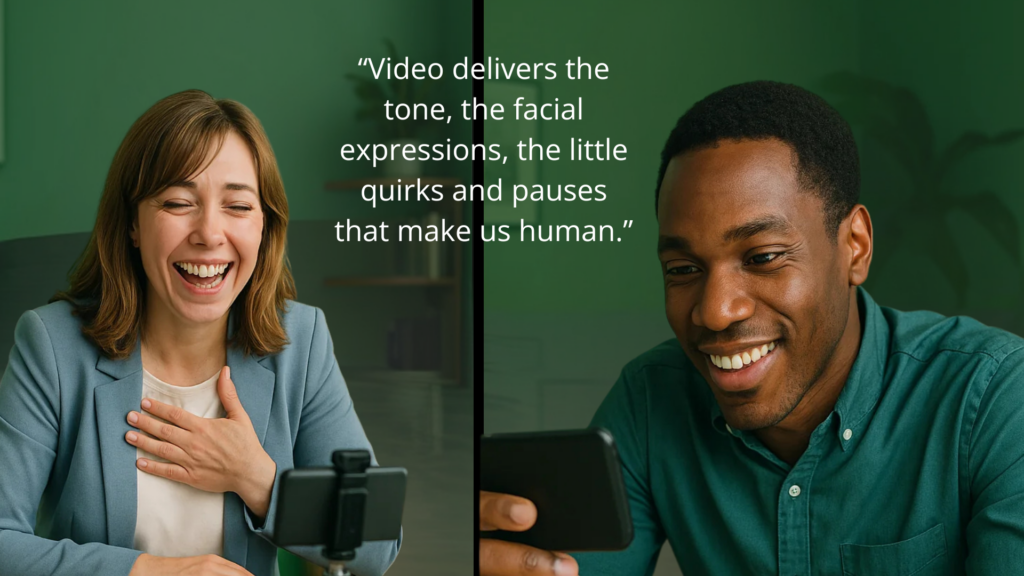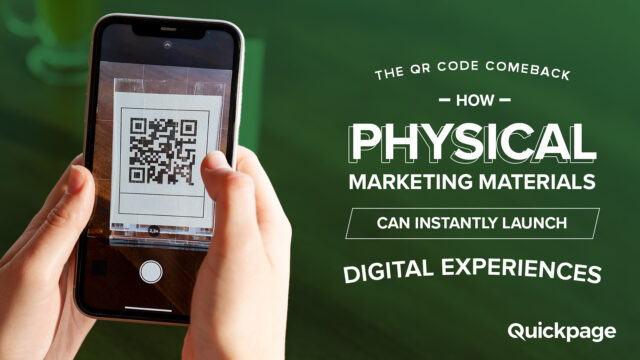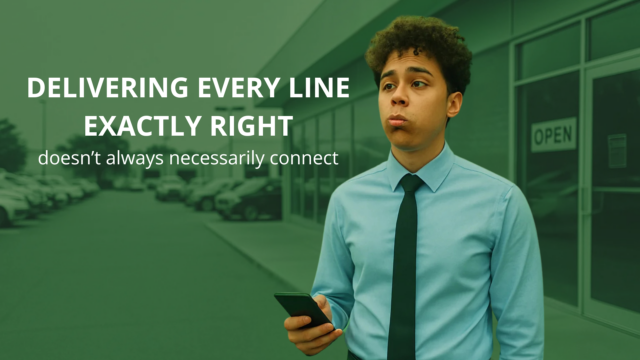I used to think sales was about being flawless. Boy, was I wrong.
Back in my early days, I was selling direct mail ads in a local magazine. I’d memorized my mentor’s pitch word for word. This guy was a legend, smooth, confident, knew how to close. I figured if I just said exactly what he said, I’d win too.
Spoiler: I didn’t.
I was so focused on delivering every line just right that I couldn’t actually connect. I sounded like a robot running on low battery. You could see the owners sizing me up the moment I walked in, tense shoulders, sweaty palms, eyes darting to the ceiling for divine intervention. Half the time they shut me down before I even spoke. The other half? Rejections. All of them.
Then one day I cracked. I couldn’t keep doing the script. I walked into a business, ditched the pitch, looked the owner in the eye and said, “Listen… I’m new at this. I’m probably gonna stumble through this conversation a bit, but I really believe in what I’m offering and I’d love to tell you why.”
Everything changed.
Instead of brushing me off, they leaned in. They listened. They related. I wasn’t some polished sales machine, I was a real human. Nervous? Sure. But also honest, and genuinely trying to help. That day, I made my first sale. Not because I was perfect, but because I wasn’t.
The BS Radar Is Always On
Think about it: most buyers are walking around with their BS radar turned all the way up. They’ve been burned, pressured, ghosted, upsold, and spammed. So the moment they feel someone’s putting on a sales act, the wall goes up.
That’s why authenticity is so powerful in sales. It’s disarming.
When someone shows up as themselves, not overly polished, not trying to impress, but just real, curious, and human? It’s like a breath of fresh air. Buyers lean in, not because of what you’re saying, but because they trust that you’re not hiding anything.
There’s also a deeper layer. Sales brings out people’s defenses. The minute someone feels sold to, their brain starts looking for reasons to say “no.” But if they feel like they’re talking to a friend or a guide, not a pitchbot, that resistance fades.
Authenticity works because it flips the script. It moves the conversation from transactional to relational. And in a world full of perfectly filtered content and AI-generated everything, being real is now the differentiator.

Video Is Where It Gets Real
In-person, you can build rapport with eye contact, a handshake, maybe even a joke if the moment’s right. But when you’re not in the room, when you’re just a name in an inbox or a line of text, you’re fighting for attention and trust in a sea of sameness.
That’s where video changes everything.
The first time I sent a raw, unscripted video message to a lead, it wasn’t slick. The lighting was bad, I was holding my phone, and I probably said “um” five times in 30 seconds. But guess what? They watched it. They smiled. They responded. Why? Because they saw a real person, not a corporate avatar.
Video delivers the tone, the facial expressions, the little quirks and pauses that make us human. You can’t fake that (well, not without AI, but that’s a whole other conversation). When someone sees you showing up as you, no filter, no script, they feel like they know you. And trust follows that feeling.
Plus, there’s this stat I love: 93% of communication is non-verbal. That means your tone, body language, and presence carry way more weight than your words. That’s why a short, imperfect video builds more connection than the most polished, word-perfect email ever could.
The Pratfall Effect
There’s actually science behind why imperfection works. It’s called the Pratfall Effect, a psychological phenomenon that says people actually like you more when you show your imperfections, as long as you’re competent.
Coined by psychologist Elliot Aronson, it’s based on research showing that a person who’s skilled but spills coffee on themselves (a “pratfall”) is seen as more relatable, human, and likable than someone who’s flawless. Why? Because perfection can feel intimidating, fake, or even annoying. But a little stumble? That’s endearing.
In sales, this means your quirks, bloopers, or off-script moments don’t hurt you, they help you. They make you trustworthy. Human. Real.
I had a rep who was just starting to use video, and he was determined to get it right. I mean, this guy treated his first video like a Netflix special. He ironed his shirt, found the perfect lighting, rehearsed his script like it was opening night on Broadway… and then recorded a 2-minute monologue that could’ve been AI-generated. It was technically flawless, perfect tone, clean background, tight script.
And it completely flopped.
The lead didn’t respond. When we followed up, they admitted they hadn’t even watched more than 10 seconds. Why? Because it felt staged. The rep didn’t blink. Didn’t smile. Didn’t sound like someone reaching out to help, he sounded like someone auditioning for a role.
That’s when it hit me: people don’t want a sales robot. They want you. They want the stumbles, the laugh at your own mistake, the quick glance at notes, it’s those moments that say, “I’m not performing for you… I’m connecting with you.”
Polished Human Is The Sweet Spot
Now, this doesn’t mean you should wing it and hope for the best. There’s a sweet spot between being a mess and being magnetic. I call it “polished human.” That’s the goal.
When I’m training sales teams, I tell them: Be prepared enough to know your stuff, but loose enough to be yourself.
Here’s how I coach it:
Know your talking points, not your script. Rehearsing a pitch word-for-word turns you into a performer. But knowing your key points means you can adapt on the fly, read the moment, and sound natural. You can’t build trust if you’re busy trying to remember line #7 in your script.
Practice on video, but keep the bloopers. I have reps record themselves and watch it back. Most people hate seeing themselves at first, but that’s where the magic is. When they see the version that feels real, we highlight that. Sometimes the best take is the one where they laugh mid-sentence or stumble and recover. That’s what people connect with.
Lead with honesty. I’ll coach reps to admit if they’re new or nervous. “Hey, I’m still getting the hang of this video thing, but I wanted to say hi face-to-face…” That kind of realness drops defenses instantly. It turns the viewer from skeptic to supporter in 10 seconds flat.
Let go of looking cool. Honestly, the more someone tries to look polished, the more awkward it gets. I remind them: You’re not filming a Super Bowl ad, you’re sending a message to one person. So show up like you would if you were just walking into their store or shaking their hand.
I always say: Be a human first, a salesperson second. Strategic imperfection isn’t sloppiness, it’s intentional humanity. And it’s the fastest route to trust.

The Imperfections That Work
Not all imperfections are created equal. There are certain types that actually boost trust because they feel so human and unscripted. In my experience with video, these are the ones that prospects seem to love the most:
1. Admitting You’re New (or Nervous)
There’s something oddly powerful about saying, “Hey, I’m still figuring this out, but I wanted to reach out personally.” It’s disarming. It shows humility. It says, I’m not here to impress you, I’m here to help you. That’s rare in sales… and people notice.
2. Laughing at Yourself
If you mess up a word, stumble a bit, or forget what you were going to say and just laugh it off, that’s gold. It shows you’re relaxed and self-aware. Prospects think, “Oh wow, this person’s not putting on a show. They’re just being them.”
3. Messy Backgrounds / Real Environments
I’ve seen reps send videos from their car, their office, even the dealership lot. And guess what? Those convert way better than some perfectly lit, sterile studio video. Why? Because it feels real. It shows you’re working, you’re in the trenches, and it feels personal.
4. Using the Prospect’s Name in a Casual Way
Not in a robotic, “Hello [first name]” way – but in a human way: “Hey Sarah, I know you’re probably getting a bunch of these, but I wanted to show you something real quick…” That’s authentic. That’s attention-grabbing.
5. Visible Energy and Sincerity
This one’s less about what you say and more about how you show up. If your energy matches your words – if they can feel that you’re excited, or genuinely curious, or even just grateful for their time, it lands. It builds trust in a way no script ever could.
But Does It Actually Work?
This isn’t just a feel-good philosophy. There’s hard data to back it up.
When sales teams make the shift from scripted, polished pitches to authentic, personal video communication, the metrics don’t just improve, they jump.
Take Southwest Exteriors, for example. Once their reps started using simple, unscripted video messages, with names on whiteboards, casual language, and a real smile, we saw a ripple effect across their funnel:
Issue Rate jumped from 79% to 87%
Demo Rate skyrocketed from 76% to 91%
Close Rate jumped by 27% over time
Why? Because they stopped trying to “sell,” and started trying to connect.
Same thing with JSB. One of their reps, Garrett, started sending short, personalized video confirmations instead of standard appointment reminders. Suddenly, the no-show rate dropped. Customers showed up warm, smiling, and already saying things like, “I feel like I know you!”
It’s not about flashy production. These videos weren’t shot in studios, they were shot in cars, driveways, kitchens, and showrooms. What made them powerful was that they felt real.
We’ve also seen:
96% open rates on text messages with video links
83% engagement rates when video is used early in the lead process
And in many cases, reduction in cancellations from 20-25% down to 8-10%
The pattern is clear: when teams lead with authenticity, trust goes up, and so do conversions.
The Future Belongs To The Real
As AI-generated content becomes more prevalent, authentic, imperfect human communication is about to become even more valuable. Maybe the most valuable thing of all.
Right now, everyone’s running to AI like it’s the magic bullet, auto-generated emails, AI avatars doing video pitches, bots handling first touches. And don’t get me wrong, there’s a place for AI. It’s a tool. But here’s the problem – people can smell automation from a mile away. And it doesn’t build trust. It doesn’t build connection. It just feels lazy.
In fact, we’re already seeing this shift happen – some platforms are now requiring companies to disclose when a video has been AI-generated. Think about that. If you have to put a little disclaimer that says “This was made by a robot”, that’s basically code for “Hey, I didn’t care enough to show up myself.”
Meanwhile, the sales reps who are willing to send a quick, imperfect, human video, where it’s obvious they took 30 seconds out of their day to look into the camera and talk like a real person, that’s going to cut through the noise like never before.
It says: “I’m here. I care. I’m not outsourcing this moment to a machine.”
And in a world where AI is generating more content, faster than ever, human content will feel rarer. More intentional. More trustworthy. It’s going to mean something.
Over the next few years, I think we’ll see two kinds of salespeople:
The ones hiding behind tech because it’s easier…
And the ones using tech to do the boring stuff faster, so they can show up more human where it really counts.
Guess which ones are going to win long-term?
So yeah, you could spend hours crafting the perfect pitch…
Or you could show up as yourself, quirks and all, and actually be remembered.



